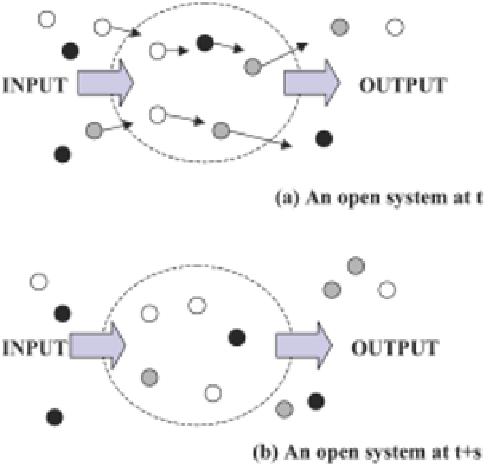Information Technology Reference
In-Depth Information
will deteriorate over time, according to the second law, if there is no importation of en-
ergy and materials from the environment and processing of information. Another type
of equilibrium will be introduced in the next section.
Homeostasis and the behaviour of open systems
It is necessary for many systems to maintain their equilibrium in changing environments
or disturbances, otherwise they cannot function properly or their goals cannot be at-
tained. In living systems, the process of self-maintenance or 'homeostasis' is essential to
ensure their survival and viability. The term homeostasis is referred to by Flood and
Carson (1993) as a process by which a system preserves its existence through the main-
tenance of its dynamic equilibrium. This equilibrium is termed 'homeostatic equilibrium'
(Van Gigch, 1978). Thus, a mature organism as an open system appears to be unchanged
over a period of time because there is a continuous exchange and replacement of matter,
energy, and information between the system and the environment. Homeostasis can be
explained mathematically as follows (Flood and Carson, 1993): If we define
x(t)
as the
state vector at time
t
and
x(t+s)
as the state vector at time
t+s
, the preservation of the
system's condition over a relatively short period of time can be represented by a state-
ment:
x(t)
=
x(t+s)
, which means that at
t+s
, the identity of the organism may appear
to be unchanged; however, the actual materials that constitute the organism at time
t
will be partially or entirely replaced by time
t+s
. This can be shown graphically as in
Figure 11.1.
Figure 11.1. Homeostasis in an open system at
t
and
t+s
. Adapted from
Flood and Carson (1993).
Homeostasis is not only one of the most important properties of any living organism,
but is also readily applicable to human or work organisations treated as open systems.
The organisation needs to recruit new employees to replace those who retire; it also
needs raw materials, energy, and information for use in its processes and operations to
maintain a steady state. In fact, an organisation that appears externally static and un-

Search WWH ::

Custom Search